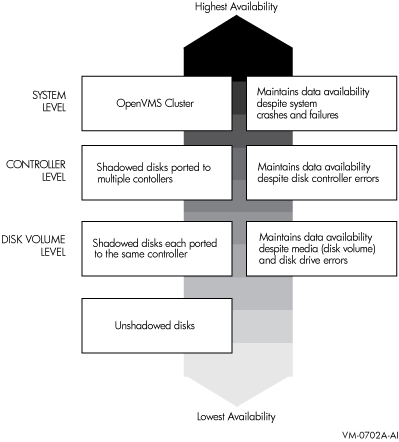Levels of High Data Availability Using Volume Shadowing
A key component of overall system availability is availability or accessibility of data. Volume Shadowing for OpenVMS provides high levels of data availability by allowing shadow sets to be configured on a single-node system or on an OpenVMS Cluster system, so that continued access to data is possible despite failures in the disk media, disk drive, or disk controller. For shadow sets whose members are local to different OpenVMS Cluster nodes, if one node serving a shadow set member shuts down, the data is still accessible through an alternate node.
You can create a virtual unit, the system representation of a shadow set, that consists of only one disk volume. However, you must mount two or more disk volumes in order to “shadow,” that is, to maintain multiple copies of the same data. This configuration protects against either failure of a single disk drive or deterioration of a single volume. For example, if one member fails out of a shadow set, the remaining member can be used as a source device whose data can be accessed by applications at the same time the data is being copied to a newly mounted target device. Once the data is copied, both devices contain identical information and the target device becomes a source member of the shadow set.
Using two controllers provides a further guarantee of data availability in the event of a single-controller failure. When setting up a system with volume shadowing, you must connect each disk drive to a different controller I/O channel whenever possible. Separate connections help protect against either failure of a single controller or of the communication path used to access it.
Using an OpenVMS Cluster system (as opposed to a single-node environment) and multiple controllers provides the greatest data availability. Disks that are connected to different local controllers and disks that are MSCP-served by other OpenVMS systems can be combined into a single shadow set, provided the disks are compatible and no more than three are combined. (Starting with OpenVMS Alpha Version 7.3-2 and OpenVMS Integrity servers Version 8.2, disks of different sizes can be combined into a shadow set, as described in “Supported Devices ”.)
Figure 2-1 provides a qualitative, high-level classification of how you can achieve increasing levels of physical data availability in different types of configurations.
“Repair and Recovery from Failures” describes how you can configure your shadowed system to achieve high data availability despite physical failures.
